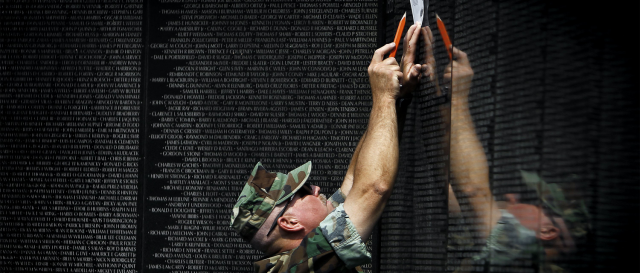
A Memorial Like No Other
In the 30 years since its dedication, the Vietnam Veterans Memorial has become one of the most popular and revered landmarks in the nation’s capital, attracting an estimated 3 million visitors each year.
Situated on a 2-acre site near the Lincoln Memorial, the Vietnam Veterans Memorial – known simply as the Wall – was the dream of a determined group of Vietnam War veterans led by Jan Scruggs, a former Army infantryman from Maryland. Scruggs founded and still leads the Vietnam Veterans Memorial Fund (VVMF), which championed the project until the Wall’s formal dedication on Nov. 13, 1982, and continues to oversee it today.
“The challenges were political and legislative initially, and in July 1980, the VVMF was authorized by Congress to build a memorial on the site,” Scruggs recalls. “Next we needed a design and had a competition – the largest ever held. Following that, we had an enormous controversy and public relations challenges over the design.”
The American Legion was an early supporter of the Vietnam Veterans Memorial, and was recognized at its dedication as the largest single contributor, donating nearly $1.2 million toward its construction.
The Wall has a distinctive look, with two polished black granite wings meeting at an apex. It stretches 246 feet in a graceful “V” formation toward the Washington Monument to the east and the Lincoln Memorial to the west, and has 70 panels ranging in height from 8 inches to 10 feet, inscribed with the names of U.S. military personnel who died or were declared missing during the Vietnam War. A total of 58,175 names were engraved on the Wall initially, but more are added periodically as new information becomes available. With the addition of 10 names in May, the Wall now lists 58,282 names.
Designed by Maya Ying Lin, then a 21-year-old Yale University architecture student, the Vietnam Veterans Memorial’s modern – some called it nonconformist – look was the unanimous choice of the eight distinguished architects and sculptors who judged 1,421 designs submitted for the design competition. Once scorned by traditionalists, the Wall has become familiar and popular within Washington’s landscape.
To address concerns that arose during the long approval process – namely, the absence of a representational sculpture – an additional tribute was erected near the Wall to honor those who fought and survived the war. Crafted by Washington, D.C., sculptor Frederick Hart, the Three Soldiers statue (also called the Three Servicemen) depicts three fighting men of various ethnic backgrounds dressed in combat attire. The bronze statue was dedicated in 1984, along with a flagpole with a large brass base emblazoned with emblems of the five military services.
In 1993, a second statue was erected on the Wall’s grounds, this one honoring the 11,000 women who served in Vietnam. Santa Fe, N.M., artist Glenna Goodacre sculpted the Vietnam Women’s Memorial, which depicts a nurse supported by sandbags as she treats an injured soldier lying across her lap. Another nurse looks skyward, perhaps for an incoming medevac flight, as a third kneels nearby.
Besides being a popular tourist attraction, the Vietnam Veterans Memorial remains the venue of choice for Memorial Day and Veterans Day ceremonies honoring those killed during the war. For 30 years these ceremonies – attended by thousands of veterans, Gold Star Mothers and members of the public – have featured the most prestigious U.S. government and military officials, civic leaders and entertainers. At the conclusion of the formal program, veterans service organizations such as the Legion participate in a solemn wreath-laying ceremony.
The story goes that the tradition of leaving personal treasures at the Wall to honor the war’s fallen heroes began even before the memorial was completed, when someone threw a Purple Heart into wet cement. That custom of leaving items at the foot of the Wall – including medals, photographs, letters and personal mementos, including a Harley-Davidson motorcycle – continues to this day. Since the Wall’s dedication, Americans have left more than 150,000 items at the memorial. They are collected, cataloged and stored by the National Park Service.
In 2003, Congress authorized VVMF to build an educational center to complement the Wall. Current plans call for the Vietnam Veterans Memorial Education Center to be built beneath a 5-acre tract of parkland between the Wall and the Lincoln Memorial, and a groundbreaking ceremony is planned for Veterans Day. Projected to open in 2014, the center will tell the story of the Wall’s 58,282 names for future generations of Americans through photographs, narrations and interactive exhibits. Several of the personal items left at the Wall over its 30-year history will also be displayed.
“For those of us who served, the Wall is our legacy,” said Gen. Colin Powell, former secretary of state and Vietnam War veteran. “In that memorial is the collective story of over 58,000 brave men and women who gave their lives for their country. This story has to be told so future generations will understand what service and sacrifice is all about. The Education Center will be a place that will enhance the Wall experience. It will keep this legacy alive for years and years to come.”
David H. Hugel served in the Marine Corps from 1960 to 1964, including a nine-month tour in Vietnam as a combat photographer with the 1st Marine Aircraft Wing as part of Task Element 79.3.3.6, code-named Shufly. Today he is a freelance writer living near Annapolis, Md.
Read more about the Education Center at the Wall: www.buildthecenter.vvmf.org
